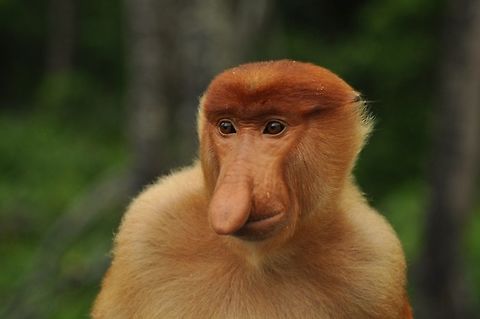
The proboscis monkey or long-nosed monkey, known as the ''bekantan'' in Malay, is a reddish-brown arboreal Old World monkey that is endemic to the south-east Asian island of Borneo. It belongs in the monotypic genus ''Nasalis'', although the pig-tailed langur has traditionally also been included in this genus. This species of monkey is easily identifiable because of its unusually large nose.
Similar species: Primates
By sarebear
All rights reserved
Uploaded Jul 21, 2016. Captured in Unnamed Road, Sandakan, Sabah, Malaysia.


comments (14)
We hope you like the site, as a warm welcome, promoted to the homepage. Posted 9 years ago
Named for its huge nose, which sags like a deflated balloon, the Proboscis Monkey (Nasalis larvatus) is endemic to Borneo. It depends on habitats near rivers and lives mostly in mangrove forests. They live in groups of approximately 20 individuals consisting of one male, numerous females, and their offspring. Among the largest of Asia's monkeys, males can reach 50 lbs (22.5 kg) with females being about half that weight. They are mostly arboreal, but are also proficient swimmers. In fact, they actually have webbed feet, which increases their stealth in the water.
The males have exaggerated physical characteristics, such as a large, fleshy, pendulous nose that can be as long as 18 cm (7 in)! As unlikely as it sounds, males use their huge honkers to attract mates. Males with the largest noses tend to have the largest harems. Additionally, their noses amplify their calls, which further impresses females, in addition to intimidating rival males. The bigger the nose, the louder the vocalization. When it comes to noses, size really matters to the proboscis monkey.
The proboscis monkey's diet consists of mostly leaves with some unripe fruit, seeds, and the occasional insect. Ninety-five percent of their diet consists of mangrove leaves. Most animals don't eat mangrove leaves because they are slightly poisonous. However, the proboscis monkey has a unique adaptation: it has several stomachs, each filled with bacteria that aid in digestion. The bacteria helps digest cellulose and neutralize the toxins. This unique digestive system is the reason why they have such large, pot-bellies. Their stomachs actually make up 25% of their body weight!
Sadly, proboscis monkeys are listed as endangered on the IUCN Red List. Populations have decreased 50% in the past 40 years, and there are only a couple thousand remaining in the wild, probably less. The main reason for their demise is habitat loss from logging and the growth of palm oil plantations. It's thought that their unattractive appearance has caused their situation to be overlooked. But, it's not only the cute creatures that deserve being saved. Raising awareness for the proboscis monkey's plight may be essential for their survival. {Spotted in Malaysia by JungleDragon user, sarebear} #JungleDragon Posted 6 years ago
As somebody on FB already commented, locals name it the Holland monkey in reference to past dutch colonists in the area, which similar to this monkey had:
A) a big nose
B) a pot belly
C) red skin (sunburn)
No, Christine, only locals can use that. Not you.
Posted 6 years ago
We’re sniffing out some notable noses today! Click on the photos to see what makes each nose unique! #JungleDragon
The Proboscis Monkey (Nasalis larvatus) is named for its large, fleshy, pendulous nose that can be up to 18 cm (7 in) long! As unlikely as it sounds, males use their huge honkers to attract mates. Males with the largest noses have the largest harems. Additionally, their noses amplify their calls, which further impresses females, in addition to intimidating rival males. The bigger the nose, the louder the vocalization. When it comes to noses, size really matters to the proboscis monkey. {Spotted in Malaysia by sarebear} #Proboscismonkey #Nasalislarvatus
https://www.facebook.com/jungledragonwildlife Posted 4 years ago